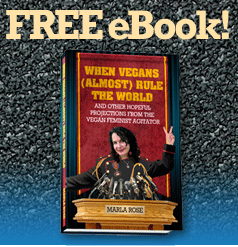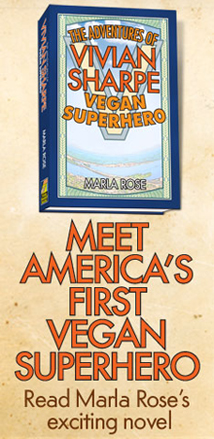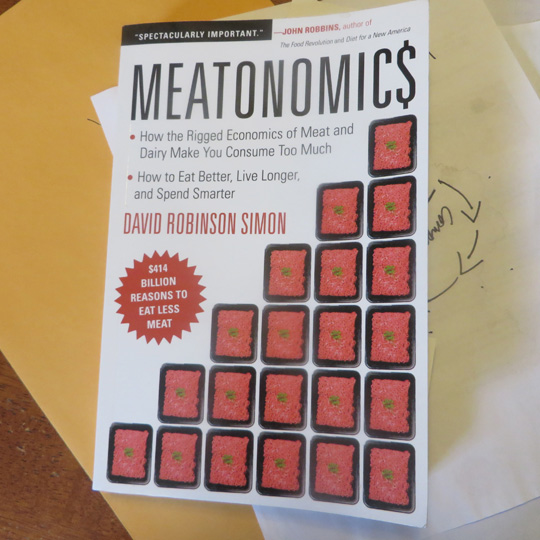
If you would prefer a printed softbound version of When Vegans (Almost) Rule the World, you can pick one up for just $11.99 at Amazon. Kindle eBook coming soon!

Available in either softbound or Kindle/Nook/etc. eBook at Amazon
viviansharpe.com

  Book Review: Meatonomics by David Robinson Simon review by John Beske Why do people eat so much meat? Some people will say it's because eating animals is a part of our culture and tradition – maybe it's even hardwired in our DNA. Or perhaps it's just so convenient and ubiquitous, or that it tastes so good or recalls happy memories. A lot of it could just be habit. And, of course, most people have been led to believe it's a healthy or even essential part of their diets. But what if there's more to it than that? After all, even though people have eaten meat in most cultures throughout human history, it's usually not been consumed in quantities approaching that of people in modern day post-industrial societies. In fact, Americans eat, on average, twice as much meat as they did a century ago. A large part of this is because it's so cheap. In most places, you can get a McDonald's hamburger for less than the price of a pound of broccoli. But why is meat so cheap? And what does all this cheap meat mean for our economy, for our health, for our planet, for our future? The answers are complex, and sometimes nefarious. And they have never been spelled our so succinctly, so thoughfully and so grippingly as they are in the powerful book from Meatonomics from David Robinson Simon. Most people who pay attention to our food economy can tell you that beef, pork, chicken, dairy, eggs and the corn and soybeans that feed all the animals that become food are heavily subsidized industries, but, as far as I know, the case has never been laid out with the care and detail as it has been here. Let's start with a couple of facts I didn't know until I read this book: • The US government collects a small tax called a Checkoff on every cow, pig, chicken and other animal (as well as eggs and dairy products) that end up in our food system, and then uses that money to finance elaborate and catchy ad campaigns to stir up consumer demand. Yep, all those "Got Milk?", "Beef, It's What's for Dinner", "Pork: the Other White Meat" and "The Incredible Edible Egg" campaigns have all been paid for with tax dollars. And they are effective! The USDA estimates that these campaigns, which collectively about cost $557 Million each year, drive additional consumption of animal products by more than $4.6 Billion each year (this one impressed us so much that we created a Daily Meme about it). • The animal industries have become exceedingly skilled in the art of "regulatory capture." They manage to install their allies and even their own exectutives into the leadership postitions at the USDA and FDA – the very agencies responsible for insuring a healthy, abundant and fair food supply for everyone – and then they make sure that all regulations coming out of these agencies primarily serve the narrow interests of the very industries they are supposed to be regulating. One result is that meatpacking operations have moved out of the cities and into rural areas where they can keep a low-wage workforce and keep most of their operations and practices hidden – restricting USDA inspectors or even replacing them with the company's own people. In some states, they've even managed to install "Ag Gag" laws which make it a crime to record or report animal cruelty, unsafe or unsanitary practices and even criminal behavior. In whole, as Mr. Simon succintly lays out, the animal industries have been thoroughly expert at externalizing all their costs while internalizing all the profits. As a result, "for every dollar in retail sales of meat, fish, eggs, or dairy, the animal food industry imposes $1.70 of external costs on society. If these external numbers were added to the grocery-store prices of animal foods, they would nearly triple the costs of these items." Mr. Simon even goes so far as to total up all the environmental, medical, ethical and economic costs that the animal industries impose on society, which add up to the staggering sum of $414 Billion per year. To get to that number, he takes us through a number of areas of concern including diseases that are caused or exacerbated by the consumption of animal products, environmental costs, food safety issues and animal cruelty. These are all widely-discussed topics among vegans, and issues we frequently address here at Vegan Street. In my nearly 20 years as an animal activist, I've argued each of these points hundreds of times, and I thought I knew this stuff about as well as anybody. And this is why Mr. Simon's research is so important and this is such a valuable book: we know that environmental damage and increased heart disease has a cost. But here we see it, all quantified and laid out with a dollar sign in front of it. It's possible to see how these issues play out on a personal level – we can see the the eyes of a hopeless pig in a factory farm, we can witness the toxic damage a river endures after being flooded with the waste from a nearby hog farm, we can hold the hand of a loved one who is recovering from angioplasty – but as soon as we start looking at the big picture it becomes overwhelming and abstract. This abstraction becomes more clear and understandable when we can quantify it, and nothing quantifies like money. And when Meatonomics starts tallying up the costs of animal agricuture, the results are quite visceral and immediate indeed. Considering the dire subject matter and the general percieved dryness of the field of economics (I used to keep a college economics textbook at my bed table as a sleep aid – three paragraphs and I was out like a light), I would have expected the book to be a snooze fest, but Mr. Simon's writing is witty, relaxed and compelling. He actually manages to make this a hard book to put down. His facts are always effortlessly in context as he turns over one rock after another to expose the slimy mechanics hidden below. All of these shady dealings, misguided laws and counterproductive regulations are almost as fascinating as they are horrible. This does not mean this is a completely easy book to read, or at least not for me. Some of the facts he uncovered angered me nearly to the point of hyperventilation. On several occasions, I had to leave the room and cool down for a while. Fortunately, in the end he does provide a couple of solutions: the obvious personal one – stop participating in this messed up system by eliminating animal products from your diet and your life; and second, a macrocosmic plan to increase taxes on meat, purge the giant agribusinesses out of the USDA, and reallign agricultural subsidies to line up with people's needs rather than further lining the pockets of these giant corporations. The plan is elegant in its simplicity, and it would help solve some of the world's most pressing problems. I'm afraid that for now, though, our political system is too broken with too much power being given to the wealthy and self-interested, and too many people are unwilling to look beyond their own dietary habits to ever see the system for what it is. It's going to take some time, a lot of grassroots effort and perhaps even a food scare or some other collapse to usher in a large-scale shift away from eating animals. In this meantime, Meatonomics is a book every vegan activist should read and take to heart, because it could become one of the strongest tools in our belts as we continue to move forward. © 2013, 2014, Vegan Street |













 |
 |
 |
 |
 |
 |
 |